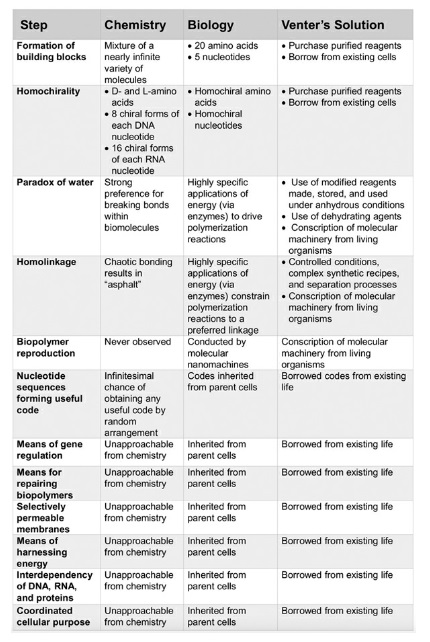Has life been recreated in the Lab?
Tan, Change; Stadler, Rob. The Stairway To Life
Venter ascended the Stairway by stacking the deck in his favor, by borrowing from existing life, and by injecting human intelligence along the way. Venter skipped the first two steps (formation and concentration of building blocks and homochirality of building blocks) by purchasing purified homochiral nucleotides that were produced with the help of living organisms and by borrowing the other building blocks from existing life (Capri). Venter overcame the paradox of water via carefully designed reactions that used selectively activated and inactivated reagents that are synthesized, stored, and used in an anhydrous and inert atmosphere. To produce homolinked oligos, Venter employed complex synthetic recipes with pure reagents, separation processes, and carefully controlled conditions to block unwanted chemical bonding and to increase the probability of the desired bonding arrangement. Even under these conditions, the oligos were constrained to a length of sixty-five to one hundred base pairs because each newly added base pair had a small probability of forming an incorrect bond, and none of the reactions had a yield of 100%. To increase the length of the synthesized DNA, Venter had to borrow the molecular machinery of living organisms—machinery that already had perfect homochirality and homo-linkage—and conscripted living cells to manufacture DNA. The reproduction of biopolymers in Venter’s work was all conducted by intact living cells or the machinery borrowed from living cells. The genes, the regulatory mechanisms, and the biopolymer repair mechanisms were entirely borrowed from Myco and Capri. The membrane- and energy-harnessing machinery was inherited, but over time it was replaced through the use of its own genome. The DNA donor and the recipient cell Capri initially met the interdependency requirements of DNA, RNA, and proteins, but these were eventually all replaced by molecules produced from the Synthia genome. Finally, the host cell Capri and the Myco-based genome provided the coordinated cellular purpose that was inherited by Synthia. Perhaps Venter’s bold summary of Synthia—“the first self-replicating species that we’ve had on the planet whose parent is a computer”—could have benefited from a proper acknowledgment of the genius of life itself.

Tan, Change; Stadler, Rob. The Stairway To Life
Venter ascended the Stairway by stacking the deck in his favor, by borrowing from existing life, and by injecting human intelligence along the way. Venter skipped the first two steps (formation and concentration of building blocks and homochirality of building blocks) by purchasing purified homochiral nucleotides that were produced with the help of living organisms and by borrowing the other building blocks from existing life (Capri). Venter overcame the paradox of water via carefully designed reactions that used selectively activated and inactivated reagents that are synthesized, stored, and used in an anhydrous and inert atmosphere. To produce homolinked oligos, Venter employed complex synthetic recipes with pure reagents, separation processes, and carefully controlled conditions to block unwanted chemical bonding and to increase the probability of the desired bonding arrangement. Even under these conditions, the oligos were constrained to a length of sixty-five to one hundred base pairs because each newly added base pair had a small probability of forming an incorrect bond, and none of the reactions had a yield of 100%. To increase the length of the synthesized DNA, Venter had to borrow the molecular machinery of living organisms—machinery that already had perfect homochirality and homo-linkage—and conscripted living cells to manufacture DNA. The reproduction of biopolymers in Venter’s work was all conducted by intact living cells or the machinery borrowed from living cells. The genes, the regulatory mechanisms, and the biopolymer repair mechanisms were entirely borrowed from Myco and Capri. The membrane- and energy-harnessing machinery was inherited, but over time it was replaced through the use of its own genome. The DNA donor and the recipient cell Capri initially met the interdependency requirements of DNA, RNA, and proteins, but these were eventually all replaced by molecules produced from the Synthia genome. Finally, the host cell Capri and the Myco-based genome provided the coordinated cellular purpose that was inherited by Synthia. Perhaps Venter’s bold summary of Synthia—“the first self-replicating species that we’ve had on the planet whose parent is a computer”—could have benefited from a proper acknowledgment of the genius of life itself.



